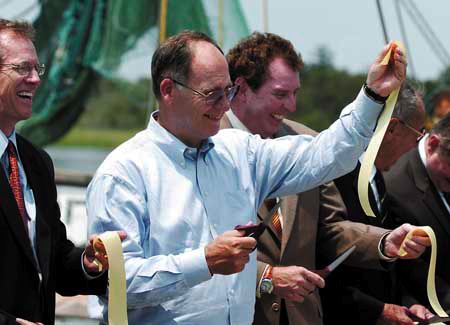| Harbor completion celebrated
Tue, Jun 19, 2007
By DANIEL SHEA
The Brunswick News
Now that its harbor is a little deeper, the Port of Brunswick is ready to grow up.

Representative Jack Kingston, left, Assistant Secretary of the Army for Civil Works John Paul Woodley and Georgia Department of Transportation commissioner Harold Linnenkohl cut a ribbon marking the completion of the Brunswick Harbor Deepening Project on Monday. (James Nix/The Brunswick News)`
|
The potential for new business growth in the Golden Isles was the focus of a ceremony Monday at Mary Ross Waterfront Park, downtown, to celebrate completion of the Brunswick harbor deepening project.
The harbor has been deepened to 36 feet and widened to a minimum of 400 feet. In all, the project that was 12 years in the making cost $117 million.
Georgia Ports Authority member and former U.S. Sen. Mack Mattingly said increased accessibility and infrastructure have helped develop Brunswick over the years, "But one of the main keys was unlocking the Port of Brunswick. Business is good now and business is going to get even better in the future."
Representative Jack Kingston, left, Assistant Secretary of the Army for Civil Works John Paul Woodley and Georgia Department of Transportation commissioner Harold Linnenkohl cut a ribbon marking the completion of the Brunswick Harbor Deepening Project on Monday. (James Nix/The Brunswick News)
This possibility for increased international trade is what convinced the federal government to join the state in funding dredging by the U.S. Army Corps of Engineers, said John Paul Woodley Jr., assistant secretary of the Army for civil works.
"The projections on international trade have been increasing very quickly over the past few years and they have been short," said Woodley. "Growth in trade has been such that there is a need to improve our facilities and harbors."
The deepening of the harbor is just the icing on the cake when looking at the big picture, said Doug Marchand, executive director of the Georgia Ports Authority.
With the completion of the new Sidney Lanier Bridge in 2003 and an increased number of rail lines to move products in and out of Brunswick, the port is now ready to embrace fully its potential growth.
Now every automobile and rolling stock vessel can be accommodated in the harbor, with there being increased access for deeper draft vessels, as well. Marchand added that Colonel's Island, a staging area for vehicle shipments, has 900 additional acres for potential development.
"We woke up a sleeping giant and now both eyes are open," said Capt. Edwin Fendig of the Brunswick Bar Pilots Association. "All this infrastructure work is coming together at the same time."
The port has already witnessed some of the economic benefits, now moving more than 300,000 vehicles through the harbor annually. An additional 50,000 should be expected with the decision by Mercedes-Benz USA to move operations to Brunswick.
The deepening was also a key selling point for Wallenius Wilhelmsen shipping lines' decision to make Brunswick its Georgia headquarters, said Robert Morris, director of external affairs at the Georgia Ports Authority.
More negotiations are in the works, as well, he said.
Georgia's deepwater ports annually produce $35.4 billion in revenue and are responsible for 7 percent of the state's total employment.
While the majority of the project is completed and open, the South Brunswick River channel and the East River turning basin are expected to be finished this year
|